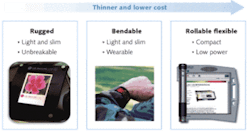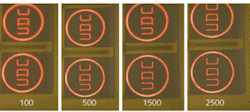FLEXIBLE DISPLAYS: Metal-foil-backed OLED displays will soon be rollable
MICHAEL HACK, RUI-QING MA, and JULIE J. BROWN
This last year has been an exciting one in the development of organic light-emitting displays (OLED), with the launch of many products containing OLED displays. Samsung SDI (Seoul, Korea; now Samsung Mobile Display, with its very recent merger with Samsung Electronics mobile-display groups) and Chi Mei EL (Tainan City, Taiwan) have produced several cell-phone-size displays in a range of products, Sony (Tokyo, Japan) introduced its groundbreaking 11 in. TV, and several other display manufacturers have also started OLED display production.
In fact, nearly every flat-panel-display manufacturer has plans for OLEDs. LG Displays, Matsushita, Toshiba, and AU Optronics have all announced products for 2009. This interest stems from several important factors. Organic LEDs provide an exceptional visual image quality, offering very high contrast and excellent color reproduction in a very thin form factor, all with good viewing angles and fast video response rates. In addition, using phosphorescent OLED technology, the display power consumption can be significantly less than an equivalent backlit active-matrix liquid-crystal display.
The next step in OLED development is technology that will enable bendable and flexible displays. Through our work on this technology, we have recently demonstrated a prototype flexible display that may soon lead to revolutionary display products.
Making use of triplets
Organic LEDs are relatively simple devices. They consist of a series of thin organic molecules deposited between two electrodes. By applying a voltage across the device (usually around 4 to 5 V), charge is injected and converted into photons through the formation and subsequent recombination of excitons–the bound molecular excited state. Excitons come in two different forms: singlets and triplets, depending on the spins of the electrons and holes that came together to form the exciton.
In a conventional fluorescent OLED, the internal quantum efficiency is limited to approximately 25% because only the singlet excitons recombine to emit light. In the phosphorescent OLED (PHOLED) system, however, heavy-metal atom centers enable efficient spin-orbit coupling, allowing both singlet and triplet excitons to be harvested as phosphorescent radiation in the guest-host systems, leading to internal quantum efficiencies of up to 100%. This level of efficiency means that PHOLED displays use much less power than fluorescent OLED displays and result in up to three times reduction in display temperature rise compared to a fluorescent OLED display. Temperature is an important consideration for handheld mobile devices.
The fabrication of an OLED display requires the integration of several key technologies. First, the individual pixels need to be addressable; this is performed using a thin-film transistor (TFT) backplane. On top of the backplane is the OLED frontplane. Because OLED devices degrade in the presence of oxygen or moisture, the final device needs to be encapsulated to ensure long operational lifetimes.
The first OLED products were fabricated using TFTs deposited onto glass substrates using techniques developed for the active-matrix liquid-crystal-display industry, with the glass package providing the necessary encapsulation. Because OLEDs are thin, all-solid-state devices, however, they can be deposited on flexible substrates, such as plastic or thin metal foil. In these cases, the encapsulation package also needs to be flexible, and so the industry is developing thin-film encapsulation technologies capable of achieving high-performance permeation barriers necessary to prevent OLED degradation.
Working toward rollability
There are clearly many advantages to using materials other than glass for displays. The first set of advantages relates to making rugged displays that do not break easily, which is important for mobile and automobile applications (see Fig. 1). Another advantage is the ability to make conformable devices that can be, for example, shaped to fit around a human arm to make a wearable display. Finally, OLEDs offer the ability to make rollable or foldable displays in which the active area of the display can be much larger than the display’s housing. This allows large-area mobile displays to be carried around in small devices, and pulled out from a penlike case or housing for viewing. Clearly, such a display would make a truly revolutionary communication device.
For several years now, we have been pioneering flexible OLED (FOLED) technology, and in particular developing the technology components that will enable rollable OLED displays–that is, OLED displays that can be repetitively flexed. Such a high-information-content OLED display requires a more stringent set of technical requirements to ensure that the entire display, including the thin-film-transister backplane, OLED frontplane, and encapsulation can withstand the stresses of multiple-flex usage.
While thin plastic films are one choice for the FOLED substrate, there is an incompatibility today between the temperatures required for the fabrication of a TFT backplane capable of driving an OLED display (greater than 300°C), and the maximum allowed process temperature of low-cost plastic substrates. For this reason, we have selected thin stainless steel as our FOLED substrate. As OLEDs are very thin-film devices (total organic-stack thickness on the order of 100 to 200 nm), the substrate surface needs to be very smooth to avoid short-circuits. We have accomplished this by applying a polyimide planarization on the metal substrate prior to TFT fabrication.
Our early demonstration of QVGA active-matrix OLED displays on metal foil incorporates an amorphous-silicon TFT backplane, top-emission OLEDs, and multilayer thin-film encapsulation technologies (see Fig. 2). The amorphous-silicon backplanes are fabricated by our partners at LG Displays on 76-µm-thick planarized steel foil and with a resolution of 100 pixels per inch. The top-emission OLEDs are deposited through a high-resolution shadow mask at the UDC facility using conventional vacuum thermal evaporation, and incorporating UDC’s low-power-consumption PHOLED technology. The multilayer thin-film encapsulation was provided by Vitex Systems, and L3 Display Systems developed the appropriate drive electronics.
Flex testing
Finally, we can show that indeed all the components used in these displays can be repetitively flexed without experiencing failures. Initial flexibility testing has been completed on a thin-film encapsulated flexible icon display. The display was mounted on a display flex tester that rolls and unrolls the display around a 1-in.-diameter cylinder. The tester was set-up to roll four of the eight icons around the cylinder at a rate of 50 cycles per minute. The display was electrically driven during the flex testing. Pictures of the icons were taken after every 250 cycles and used for comparison to determine damage to the display from flexing. After 2500 cycles, there was no shorting within the display and there was no observed damage to the icons (see Fig. 2).Having demonstrated prototype flexible OLED displays, we are investigating the challenges of making truly revolutionary display products based on these technologies. We believe that they will enable a whole new class of display products providing vivid, video-rate content in form factors that can be molded to fit our lives, rather than be restricted to today’s fragile and bulky form factors.
Acknowledgments
We gratefully acknowledge our partners at LG Displays and L3 Displays. We also thank Dr. Ray Schulze from the U.S. Army Communications-Electronics Research, Development and Engineering Center (CERDEC; Fort Monmouth, NJ) for financial support of this work, and our collaborations with the Flexible Display Center at Arizona State University (Tempe, AZ).
Michael Hack is vice president of strategic development, Rui-Qing Ma is department manager, flexible displays, and Julie J. Brown is chief technology officer at Universal Display Corp., 375 Phillips Boulevard, Ewing, NJ 08618; e-mail: [email protected]; www.universaldisplay.com.

